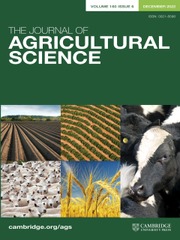Article contents
Radiation use efficiency and canopy structure of contrasting elephant grass varieties grown as monocrops and intercrops with butterfly pea
Published online by Cambridge University Press: 11 January 2023
Abstract
The objective of this study was to evaluate the radiation use efficiency (RUE) and canopy structure of elephant grass varieties (Cenchrus purpureus Schum.) of contrasting statures, under monocropping or intercropped with butterfly pea (Clitoria ternatea L.) in cut-and-carry systems. Two tall varieties (elephant B and IRI-381), and two dwarf ones (Mott and Taiwan A-146 2.37), were evaluated as monocrops or binary intercrops with the legume in a 2-year trial with eight harvests. Greater annual leaf biomass accumulation was observed in the monocrops of the tall variety elephant B (7.76 t/ha per year) and dwarf Mott (8.08 t/ha per year). Greater herbage bulk density (59 kg/ha per cm) and leaf area index (3.83) were recorded in canopies of dwarf Mott than in those composed of IRI-381 (37 kg/ha per cm and 3.48, respectively). In the first year, dwarf varieties Mott and Taiwan A-146 2.37 showed less RUE (0.89 and 0.84 g dry matter (DM)/MJ, respectively) than the elephant B (1.46 g DM/MJ). Higher non-fibre carbohydrate (NFC) contents were found in dwarf Mott under monocrop (180 g/kg) and in the intercrop systems. Tall varieties elephant B and IRI-381 showed greater efficiency in intercepting the radiation to accumulate herbage via stem accumulation. Dwarf Mott variety exhibited short stems and great leaf biomass accumulation that favoured denser canopies with higher content of NFCs in vegetal tissue. Planting butterfly pea into rows of elephant grass varieties can be adopted with no significant losses in RUE caused by light extinction, regardless of the grass stature.
Keywords
Information
- Type
- Crops and Soils Research Paper
- Information
- Copyright
- Copyright © The Author(s), 2023. Published by Cambridge University Press
References
- 1
- Cited by


